Understanding Wind Dings in Kiteboarding Performance
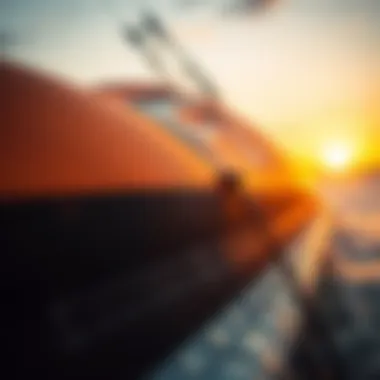
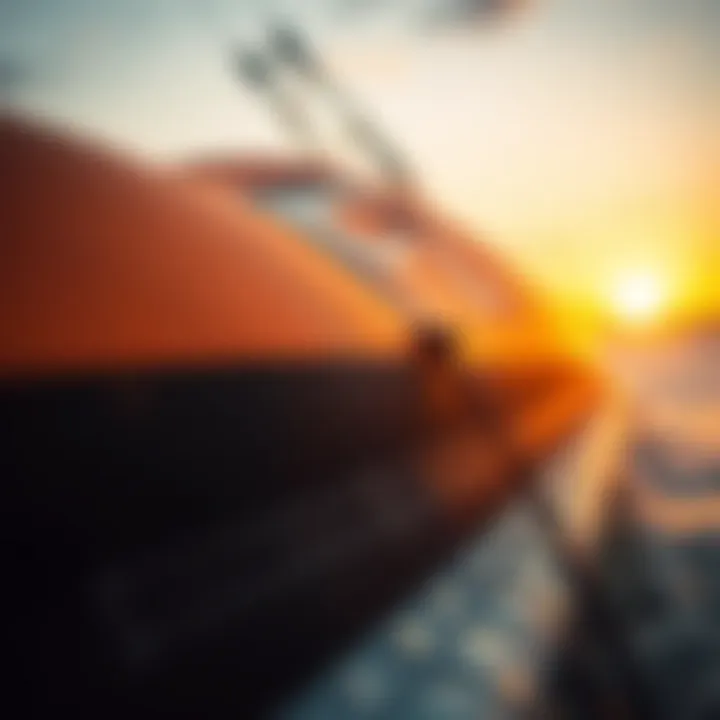
Intro
Kiteboarding can be an exhilarating sport, but there's more to it than just riding the waves and catching air. One common yet often overlooked aspect is wind dings. These minor imperfections can significantly impact your kite's performance and, by extension, your safety while engaging in the sport. Understanding what wind dings are, how they occur, and how to manage them is crucial for anyone serious about kiteboarding.
In this guide, we’ll dive deeply into wind dings, addressing various facets of the topic. You'll find techniques that cater to both beginners and advanced riders, practical equipment reviews, and expert advice on best practices. The aim is to provide an extensive understanding of the implications of wind dings and how to navigate them effectively. By the end of this article, you should be well-equipped to enhance your kiteboarding experience.
Techniques for Kiteboarding Enthusiasts
Beginner Techniques
For those new to kiteboarding, it's essential to develop a solid foundation in both skills and equipment maintenance. Wind dings can happen easily, especially when you're just getting the hang of things. Here are some essential techniques:
- Proper Launching and Landing: Always ensure you're launching and landing your kite with care. Avoid dragging the kite across the ground, as this can lead to unsightly dings. Instead, practice launching in designated zones away from sharp objects and debris.
- Kite Position Awareness: Keep your eyes peeled on the kite’s position. Low and flat surfaces increase the risk of wind dings. Kite control is paramount; focus on mastering the kite’s flight path so you don't unintentionally crash it.
- Pre-Session Check: Before you hit the water, inspect your gear for any visible damage. Identifying potential issues early can save you from a nasty surprise mid-ride.
Advanced Maneuvers
For seasoned kiteboarders, the stakes are higher, both in terms of performance and the risk of damage. Here are some advanced techniques:
- Jumping and Landing Precision: If you're working on jumps, aim for a clean landing. Redirecting your kite properly during descent prevents it from hitting the water hard, which can lead to dings.
- Fine-tuning Equipment: Consider customizing your kite's settings based on weather conditions. High wind can increase the likelihood of crashes. Tailoring your setup can help manage this risk.
- Use of Protective Gear: Invest in durable protective stickers or patches for both kites and boards. They can act as a buffer against minor dings and extend the lifespan of your equipment.
Equipment Reviews
A kiteboarder's choice of gear plays an undeniable role in performance and durability. Evaluating your options based on personal experience and expert recommendations can be extremely beneficial.
Kite Reviews
When it comes to kites, consider the following critical factors:
- Material Quality: Look for kites made with ripstop fabric. It resists tearing and is more resilient against environmental wear.
- Design Features: Designs that focus on stability and ease of control are preferable. A kite that handles well is less prone to crashing and, consequently, to wind dings.
Some recommended kite models among the kiteboarding community are the Naish Pivot and the Cabrinha Switchblade. These kites are known for their performance and durability.
Board Reviews
Boards also play their part in the overall kiteboarding experience. Here are some aspects to keep in mind:
- Material and Shape: Look for boards that feature high-quality construction, such as carbon fiber or epoxy materials. Their robustness can mitigate the risks of dings.
- Versatility: Choose boards that can handle various conditions. Multi-use boards typically withstand rigorous usage better than specialized ones.
Popular choices include the Slingshot Misfit for its great all-around performance and durability, and the F-One Fish, which offers excellent versatility for different rider styles.
Each of these techniques and reviews will serve you well as you take on the thrilling world of kiteboarding while minimizing the risk of wind dings. Save your gear from wear and keep the focus on what truly matters: enjoying the ride.
"A well-maintained kite not only improves performance but also enhances your safety on the water." – Kiteboarding Insiders
For further insights into kiteboarding techniques and gear recommendations, you can explore additional resources like Wikipedia on Kiteboarding and discussions on Reddit's Kitesurfing Community.
Understanding Wind Dings
Understanding wind dings is crucial for anyone involved in kiteboarding. This knowledge serves as the backbone for recognizing, preventing, and addressing kite damage that can arise from various wind conditions. As a kiteboarder, safeguarding your gear not only enhances your experience but also ensures your safety on the water.
When discussing wind dings, a clear definition and knowledge of the underlying causes become essential. These dings affect a kite's performance, and without a grasp of their implications, you might find yourself facing unexpected challenges while riding. The better you comprehend wind dings, the more equipped you are to maintain your gear and optimize your performance.
In this section, we will break down the specifics surrounding wind dings, their causes, and their impact on your kiteboarding experience. Grasping these elements aids beginners and seasoned riders alike in making informed decisions, focusing not just on enjoyment but also on the longevity and resilience of their equipment.
Definition of Wind Dings
Wind dings refer to the small, often subtle, indentations or surface deviations that form on the fabric of a kite due to continuous exposure to wind and varying environmental conditions. These dings can be superficial but can also extend deeper into the kite's structure, potentially compromising its integrity.
Understanding what constitutes a wind ding is vital for kiteboarders because these imperfections, although deceptively minor, can significantly influence the kite's aerodynamic characteristics. To put it in simpler terms—if you think of your kite as a carefully crafted machine, wind dings act as dents; even little ones can render it less efficient in the air.
Causes of Wind Dings
Several factors contribute to the formation of wind dings. It’s not always the obvious gusts that wear down your kite. Understanding these causes can arm you with the knowledge to take preventive measures.
- Continuous Exposure: Repeated use of the kite in high-wind conditions can lead to fabric fatigue. Think of it as the wear and tear your favorite pair of shoes undergoes over time.
- Inadequate Storage: Tossing your kite into a damp bag or storing it improperly can invite moisture and grime, setting the stage for degradation.
- Environmental Factors: Saltwater, UV rays, and even sand can contribute. The seaside might seem paradise-like, but those elements add up to a pretty rough environment for your kite's fabric.
Taking these factors into consideration not only helps in recognizing potential damage early on, but also informs choices about when and where to use your kite.
How Wind Dings Affect Performance
The state of your kite is paramount when it comes to performance. Wind dings can be more than just unsightly marks; their presence alters the aerodynamics of the kite significantly. While these imperfections might not seem crucial at first, they can lead to several repercussions:
- Reduced Lift: An uneven surface disrupts wind flow, diminishing the kite’s ability to generate lift efficiently. Imagine trying to fly with a torn parachute—it just won’t perform as expected.
- Instability in the Air: Dings can cause erratic behavior in flight, making control difficult and challenging your skills as a kiteboarder.
- Compromised Control Response: Any imperfections can lead to delayed responses when steering, which can be crucial during high-speed maneuvers or tricky environments.
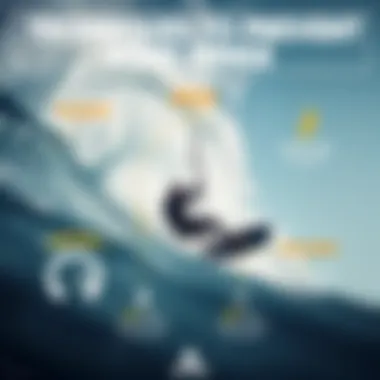
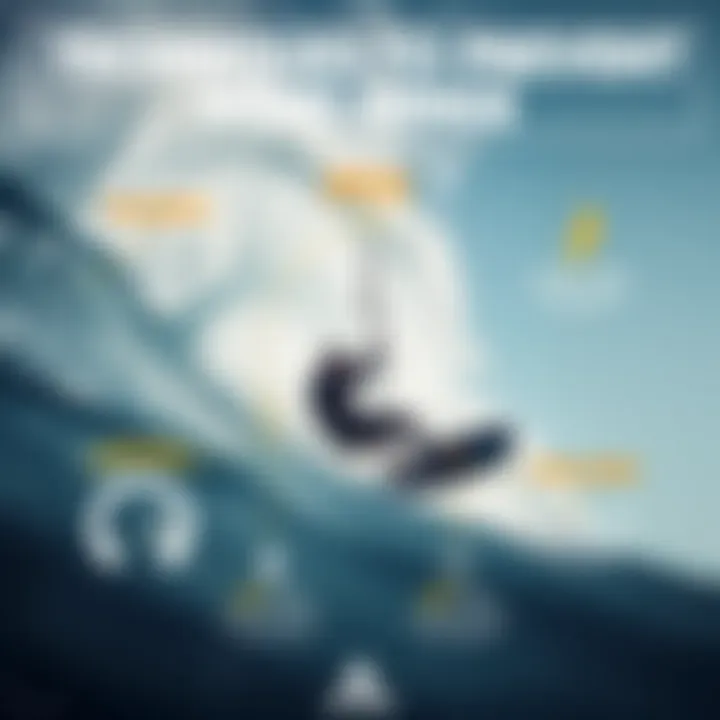
The connection between wind dings and performance cannot be undervalued. By proactively addressing these issues, you can maintain not just your kite but also the enjoyment and safety of your kiteboarding adventures.
The Physics Behind Wind Dings
Understanding the physics governing wind dings is crucial for anyone involved in kiteboarding, whether you are a novice just starting out or a seasoned rider. The behavior of kites in various wind conditions can directly affect performance, safety, and the longevity of your gear. Moreover, grasping these concepts helps riders make informed decisions that enhance their experience on the water.
Pressure Variations in Kite Fabric
Kiteboarding isn’t just about the thrill—it’s also a delicate dance with the elements. One core aspect to consider is how changes in wind pressure affect the fabric of a kite. When wind speeds fluctuate, different areas of the kite experience varying levels of pressure, which can lead to fabric distortion.
Imagine riding in a strong gust; the fabric stretches, creating excess pressure in certain spots. This can result in misaligned seams or, worse, permanent damage. To visualize this, picture blowing up a balloon: if you pump air too quickly, the balloon expands unevenly, leading to weak spots.
Regularly checking the kite fabric for these pressure-induced changes is essential. Are there visible wrinkles or bulges? It might indicate you need to reassess your flying techniques or even your equipment.
Dynamics of Kite Interaction with Wind
The relationship between a kite and the wind is dynamic and multifaceted. As the wind shifts, it creates different patterns of lift and drag on the kite. Understanding the dynamics at play will not only improve your maneuvering abilities but also lower your risk of damage.
For instance, when a kite is angled towards a strong wind, it pulls more aggressively, sending sharp vibrations through the structure. A lack of understanding here could lead to harsh landings or crashes that induce wind dings. Adjusting your angle can make all the difference, as it reduces stress and maintains smoother performance.
What’s more, factor in turbulence. Winds whirling around nearby objects or natural formations can create unexpected challenges. Riders should develop a keen eye for recognizing these wind patterns and their implications.
The Role of Material Composition
Finally, let’s discuss the materials used in kite construction. Different fabrics come with their own strengths and weaknesses—some are designed for speed and agility, while others are meant for durability in hard conditions. Choosing the right material can greatly reduce the likelihood of wind dings.
Consider this: lighter materials can boost your speed, but could be more prone to damage during rough conditions. On the contrary, heavier materials might not perform as well in light winds. Each choice carries its own trade-offs. It’s beneficial to weigh your riding style against the kite's material specifications.
For instance, a kite made from ripstop nylon may be lighter but might not withstand rough crashes. Conversely, a kite with a polyester blend, while heavier, could significantly increase its longevity.
"Kiteboarding is a game where knowledge meets skill, especially when it comes to the materials you choose. Stay informed; your safety and performance depend on it."
In summary, understanding the physics behind wind dings goes beyond mere theory. It's about making practical decisions informed by the dynamics of wind pressure, kite interaction, and material properties. Each factor plays a crucial role in maintaining not just the integrity of your kite but also your enjoyment of the sport.
Identifying Wind Dings
Identifying wind dings is crucial for any kiteboarder who wants to maintain optimal performance and prolong the life of their equipment. Recognizing these imperfections early can significantly reduce the risk of damage and enhance safety while kiteboarding. Understanding how to spot, assess, and address wind dings helps in ensuring that your kite continues to perform at its best. Awareness of this topic empowers riders to make informed decisions about their gear, ultimately leading to a more enjoyable experience on the water.
Visual Inspection Techniques
To detect wind dings effectively, beginning with a thorough visual inspection is essential. First off, ensure you do this when the kite is inflated, as it makes identifying subtle changes easier. Look for visual irregularities on the fabric, such as:
- Bumps or protrusions that signal damage in the material.
- Wrinkles in the fabric, which may indicate that the kite isn’t holding pressure properly.
- Discoloration or fading, pointing to sun damage or wear and tear.
Every kiteboarder should develop a keen eye for spotting these signs. Using a flashlight can also aid in identifying tiny punctures, as light will often penetrate through minor tears more readily.
Inspecting the seams is just as crucial. Seams that appear to be fraying or separating may compromise the integrity of the kite, making it essential to address these issues promptly.
Common Indicators of Wind Dings
Beyond visual cues, there are several common indicators that can reveal the presence of wind dings. Here are some symptoms to watch out for:
- Reduced performance: If your kite feels sluggish or unresponsive, it may be suffering from localized damage.
- Unusual sounds: Listen for any odd noises when the kite is in use, as extra flapping or crinkling often suggests compromised fabric.
- Loss of air pressure: If you're frequently needing to pump your kite, this can indicate leaks or punctures.
Once you notice any of these signs, it’s time to take a closer look and perhaps take action.
Being proactive about identifying these indicators not only preserves kite integrity but also keeps safety at the forefront. A damaged kite presents risks both to the rider and others in the vicinity.
Assessment Tools for Kite Integrity
For those serious about maintaining their kites, several tools can enhance the assessment process:
- Pressure gauges: These tools help you monitor the air pressure in your kite, allowing for early detection of leaks or inconsistent inflation.
- Patch kits: While not an assessment tool per se, having patches ready means you can quickly deal with minor damages that are often indicative of bigger issues.
- Kite inspection mirrors: These can be very handy for getting a better look at hard-to-reach areas of your kite, especially the underside.
Kiteboarding forums on sites like reddit.com can also offer practical advice and tips from other experienced kiteboarders on effective inspection techniques and their personal routines. Keeping a regular maintenance schedule will help in preserving the integrity of the kite, safeguarding your investment and ensuring you’re ready for every session.
Preventive Measures Against Wind Dings
Wind dings can be a pain in the neck for kiteboarders, both in terms of performance and safety. Addressing these dings before they spoil the fun is key. From material selection to regular maintenance, understanding preventive measures can save you time, money, and heartache. In this section, we'll break down crucial strategies that kiteboarders should adopt.
Choosing Appropriate Kite Materials
The kite’s fabric is the first line of defense against wind dings. Opting for high-quality materials can significantly reduce the risk of damage. Fabrics like ripstop nylon and polyester are popular for their tear-resistant properties and lightweight characteristics. Both materials strike an excellent balance between durability and performance.
When choosing a kite, look for materials that offer the following benefits:
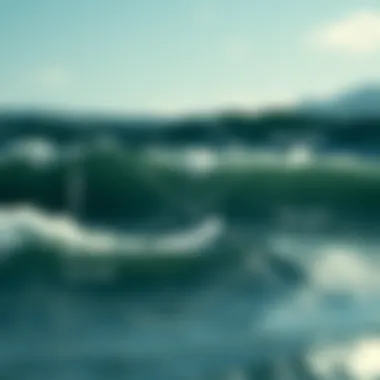

- Durability: Fabrics with reinforced stitching or double-layer construction are less likely to incur damage.
- Flexibility: A material that maintains its shape while being flexible can cope better under wind stress.
- Water Resistance: This doesn't only keep the kite dry but also protects it from degrading over time.
Addressing Wind Dings
Wind dings can be a kiteboarder's worst nightmare. When they occur, immediate attention is crucial to maintaining both performance and safety. By addressing these issues quickly, riders can preserve the integrity of their gear and enjoy longer sessions on the water. This section delves into the specific actions to take when wind dings occur, repair techniques to consider, and the instances where professional assistance might be necessary.
Immediate Actions to Take
When you notice a wind ding, staying calm is key, even if your heart's racing like a kite in a gust. The first step is to assess the extent of the damage. Here’s a clear plan:
- Stop using the kite: Continuing to fly a damaged kite increases the risk of further damage.
- Inspect the kite thoroughly: Look for tears, dents, or changes in the fabric shape. Pay special attention to areas of high stress, like seams and leading edges.
- Secure the damage: If it’s a small tear, a temporary fix, such as using duct tape, can help hold things together until proper repairs can be made.
- Document the damage: Taking photos can be useful for determining repair needs later and for any warranty claims.gain.
- Store the kite properly: Keep it flat and out of the sun, especially if you’re unable to repair it immediately. Sun exposure can worsen the damage.
Addressing wind dings with swift action can help avoid larger failures down the line, ensuring that your kite continues to perform well.
Repair Techniques for Kite Damage
If the damage is minor and you feel up to the task, repairing it yourself can save time and cost. Here are the common repair techniques:
- Sewing: For larger tears, sewing the fabric can be effective. Using a heavy-duty needle and strong thread, make sure to cover all edges of the tear to prevent fraying.
- Heat-seal patches: For thin fabric areas, using a heat-seal patch is effective. It’s crucial to follow the manufacturer's instructions for applying these patches properly.
- Adhesive patches: In cases where sewing isn’t feasible, consider using specialized kite repair adhesive patches. Clean the area around the ding thoroughly, apply the patch, and allow it to cure as per the instructions.
- DIY repair kits: Many companies offer full repair kits tailored to kiteboarding needs. Investing in one can be beneficial for those situations that arise suddenly, giving you the tools you need to quickly take action.
Keep in mind that when performing your repairs, prioritizing clean and dry conditions can greatly increase the effectiveness of your fixes.
When to Seek Professional Repairs
While some repairs can be done on your own, there are times when seeking professional help is the best course of action:
- Complex damage: If you find substantial damage that alters the fundamental shape or structure of the kite, professional expertise is often necessary.
- Material concerns: If the damage involves advanced materials that require specific knowledge or tools, it’s wise to leave it to the experts.
- Safety over performance: If there's any doubt about the kite's safety after repair, consulting a pro is critical to prevent accidents on the water.
- Manufacturer warranty: If your kite is under warranty, any professional repair might need to be carried out by an authorized service to ensure coverage remains valid.
Maintaining a healthy relationship with a local kite shop or repair specialist can be invaluable. They can provide insights into repairs, recommend best practices, and even help keep your gear in top shape overall.
In conclusion, addressing wind dings not only preserves the life of your equipment but also enhances your riding experience. By being proactive and informed, you can ensure that challenges like wind dings do not ground your fun in the water.
Recommendations from Experts
Understanding wind dings is crucial for kiteboarders looking to improve their performance and prolong the lifespan of their equipment. Experts in the field emphasize that taking advice from seasoned professionals can greatly enhance one’s approach to kiteboarding. The importance of these recommendations stems from several key elements.
First and foremost, expert insights help kiteboarders avoid common pitfalls that lead to wind dings. These dings can be a major source of frustration, especially when they impact performance. By following best practices instilled by experience, riders can minimize damage to their kites, boosting reliability and overall enjoyment on the water.
Additionally, the importance of using the right gear cannot be overstated. With countless kite designs and materials out there, knowing what works best in specific conditions is invaluable. Experts often share not just what to use, but how to maintain it to prevent wear and tear over time.
Here are a few practical recommendations:
- Stay informed: Regularly research and familiarize yourself with recent discoveries in kite design and material improvements.
- Engage with the community: Learn from other kiteboarders through forums such as reddit.com/r/kiteboarding or local kiteboarding clubs.
- Evaluate your environment: Different locations present different wind challenges, so understanding this can offer tailored solutions to reduce risks of wind dings.
"Experience is the best teacher. Tap into the knowledge of those who have learned through their own trials and errors," advises an experienced kiteboarding instructor.
Best Practices from Experienced Kiteboarders
When it comes to avoiding wind dings, experienced kiteboarders have adopted several best practices:
- Regular Inspection: After each session, inspect the kite for any signs of wear or potential dings that might go unnoticed.
- Proper Launch Techniques: Ensure proper launch techniques; avoid abrupt movements or launching during turbulent wind conditions.
- Correct Storage: After using, always store the kite in a cool, dry place away from sunlight.
- Adapt Riding Style: While freestyle maneuvers can be exhilarating, they can also increase the risk of kite damage. Adjust your riding style to suit the kite's condition and the wind intensity.
- Try Different Kites: Experiment with different kite types to find the one that matches your skill level and the specific wind conditions you typically encounter.
Insights from Kite Manufacturers
Kite manufacturers, like Duotone and Cabrinha, invest heavily in research and development to create durable equipment tailored for all wind conditions. Their insights are invaluable for kiteboarders.
- Material Durability: A lot of kite damage occurs due to the materials used. Many manufacturers now use ripstop materials that are lightweight yet resistant to tearing.
- Shape Innovations: Changes in kite shape can drastically affect performance and resilience against the wind. Newer designs offer better aerodynamics and reduced drag.
- Testing Standards: Most reputable brands uphold rigorous testing standards for their products. They often share their findings with users, allowing kiteboarders to make informed choices about gear.
Common Misconceptions about Wind Dings
In the realm of kiteboarding, several misconceptions about wind dings circulate, leading to confusion and sometimes exacerbating the problem. Here are a few:
- Misconception 1: Wind dings are only a problem for novice kiteboarders. This could not be farther from the truth; even experienced riders are susceptible, depending on conditions.
- Misconception 2: All kites are equally durable. In reality, not all kites are created equal. The materials and craftsmanship involved can make a significant difference in how well they stand up to stress.
- Misconception 3: Repairing wind dings is a do-it-yourself task. While some minor repairs can be addressed at home, serious dings often require professional attention to ensure the kite remains safe and effective.
By understanding and following these recommendations from experts, kiteboarders can significantly enhance their performance, ensuring a more enjoyable and safer experience on the water.
Kiteboarding Locations with Wind Challenges
Kiteboarding is a sport driven by the wind, and the environments in which you choose to ride can greatly affect your experience. When considering kiteboarding locations, understanding wind challenges is crucial, as they directly impact both performance and safety. Whether you're a novice or seasoned kiteboarder, navigating various wind conditions can mean the difference between a thrilling session and a frustrating or even dangerous outing. This section delves deeper into high-wind areas, safe spots for beginners, and regional variations that every kite enthusiast should keep in mind.
High-Wind Areas and Their Impact
High-wind areas create unique opportunities and challenges for kiteboarders. Locations known for strong winds often attract experienced riders who thrive on the adrenaline of challenging conditions. However, this also means that the risk of wind dings increases significantly.
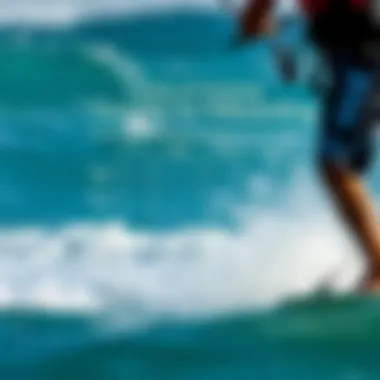

Consider the following points when kiteboarding in high-wind areas:
- Equipment Limitations: Larger kites can catch excessive wind, leading to potential damage. Utilizing smaller kites can provide better control; however, it’s vital to know your limits.
- Rider Skill Level: High winds can amplify the difficulty of riding. While some kiteboarders might enjoy the rush, beginners may find themselves out of their depth far too quickly.
- Environmental Considerations: Water conditions typically change in high winds, leading to choppy waters which can influence the intensity of your ride. Riders should pay attention to factors such as swell and chop to adjust their technique accordingly.
"Choosing the right gear for the wind conditions can keep you on your board and off the beach!"
Identifying Safe Spots for Beginners
For those just starting with kiteboarding, finding the right venue is critical. Safe spots for beginners often provide manageable wind conditions and ample space.
Things to consider for identifying suitable areas include:
- Wind Consistency: Locations like flat water lakes generally have more predictable winds. Look for recommendations from local kiteboarding schools.
- Space: Make sure there’s enough room for launching and landing kites without interference from obstructions like rocks, trees, or other watercraft.
- Supervision: Beginner-friendly spots often have instructors and other experienced riders nearby. This increases the chance of assistance should an issue arise.
Regional Variations to Consider
Wind conditions can differ dramatically across regions due to geographical features, local climate, and seasonal changes. Understanding these regional variations can empower kiteboarders to make informed decisions. Some elements to observe include:
- Coastal Locations: Often characterized by gusty winds, making it essential for riders to learn how these variances can impact flight stability.
- Inland Lakes: Generally provide smooth and consistent winds but can be subject to thermal winds or gusts when weather changes.
- Tidal Effects: In some coastal locations, tides can affect the wind patterns significantly. Understanding high and low tides can help in timing your sessions.
By arming yourself with knowledge about your chosen location, you can not only avoid pesky wind dings but enhance your overall kiteboarding experience.
Future Trends in Kite Design
As kiteboarding continues to evolve, understanding future trends in kite design is crucial for anyone passionate about this exhilarating sport. The materials and designs we see today are just the tip of the iceberg; advancements occurring now will shape how we ride in the years to come. These trends not only enhance performance but also address issues like durability and user adaptability, making the ride more enjoyable and safe.
Advancements in Material Science
The world of kiteboarding materials is undergoing a significant transformation. Traditional fabrics are being replaced or enhanced with advanced composites that offer better strength-to-weight ratios. Newer materials such as ripstop nylon and silicone-coated fabrics are emerging, providing greater resistance to tearing and wear.
- Benefits of Advanced Materials:
- Lighter Weight: Easier to handle and control in varying wind conditions.
- Enhanced Durability: Longer lifespan, which reduces costs over time.
- Eco-Friendly Options: Companies are exploring sustainable materials, appealing to environmentally-conscious riders.
This leap in material science means a kite’s performance will be more consistent across different environments. Understanding how these materials behave in various conditions allows kiteboarders to select the appropriate kite, depending on their local wind patterns and water conditions.
Innovations in Kite Design
Kite design isn't just about the materials; it's also about the shapes and functionalities that manufacturers are experimenting with. The days of one-size-fits-all kites are fading. Riders can expect to see more specialized kites developed for different styles of riding.
- Specialized Designs:
- Freestyle Kites: Designed for tricks and maneuvers that require quick responses and less drag.
- Wave Kites: Tailored for surfers, featuring a design that provides stability and control in tumultuous conditions.
- All-around Kites: For recreational users, combining versatility without sacrificing performance.
These innovations can dramatically impact a rider’s experience on the water, especially when it comes to efficiency and ease of use. With the right design, kiteboarders can enjoy better handling, leading to smoother rides and reducing the risk of mishaps.
Impact of Technology on Performance
Technological advancements are interwoven with both material science and design, leading to enhanced performance capabilities. Innovations such as integrated sensors for monitoring kite performance, automated adjustments based on wind conditions, and even smart materials that change characteristics in real-time are being explored.
- Performance Enhancements:
- User-Feedback Systems: Riders can receive real-time data, enabling them to optimize their setups quickly.
- Self-Adjusting Kites: Kites that adapt to changing wind conditions automatically, providing stability and safety.
- Interconnected Gear: Harnessing technology to create a more cohesive and intuitive riding experience.
Thanks to these trends, riders in the future may find themselves with kites that not only react faster but also provide insights based on conditions they’ve never had previously. This means more refined control and personalization in kiteboarding, sending performance skyrocketing.
"Understanding the trends in kite design not only fuels our passion but also transforms our riding experience."
For more detailed information on kiteboarding innovations, check out resources from groups like Kiteboarding.org and The Kiteboarder Magazine.
Links to explore further:
Ending and Final Thoughts
As we wrap up our detailed exploration of wind dings in kiteboarding, it's clear that understanding this issue is crucial for both safety and performance on the water. Wind dings are not just minor inconveniences; they can significantly impact your kite's functionality. Recognizing their causes and effects allows kiteboarders to approach their sport more mindfully.
Summarizing Key Points
To summarize, we first defined wind dings and analyzed their causes. We further examined how these dings can detrimentally affect kite performance, darting right into the heart of the physics involved. Our discussion of prevention highlighted the importance of choosing the right materials and design, as well as regular maintenance. We also delved into effective assessment techniques and repair options available to kite enthusiasts. As kiteboarders practice a proactive approach, the occurrence of wind dings could drastically reduce, leading to a safer and more enjoyable experience overall.
Importance of Awareness in Kiteboarding
Awareness in kiteboarding manifests as an essential skill that every rider should cultivate. It goes beyond merely managing wind dings — it encompasses understanding how your equipment interacts with the environment. By being observant of the conditions around you, you can make informed choices about where and when to kite. Awareness empowers riders to spot early signs of wear or damage, allowing for timely interventions that could save money on repairs and maintain performance standards. Knowledge of wind patterns, tide behavior, and even local regulations can make a world of difference in your kiteboarding adventures. It's not just about having fun; it's about staying safe while doing what you love.
Encouragement for Ongoing Learning
Kiteboarding, like any sport, evolves constantly. New materials and modern design concepts are bountiful, promising enhancements and optimizations for the kiteboarding gear you might currently be using. Therefore, ongoing learning is paramount. Engage with the kiteboarding community on forums such as Reddit or participate in local clubs where you can exchange knowledge. Attend workshops or clinics by knowledgeable instructors who can offer practical insights and tips. The more you learn, the better equipped you are to tackle the challenges posed by wind dings and other obstacles in your way. Remember, kiteboarding thrives on the collaboration of its community, and each shared experience strengthens the bonds we share with our sport.















